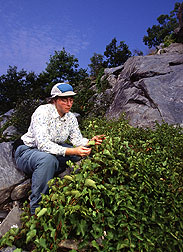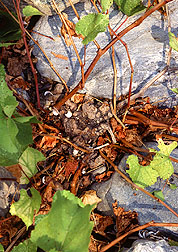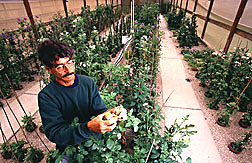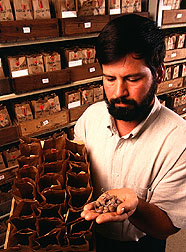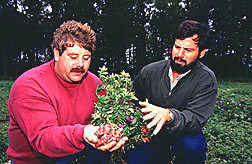Why In Situ?
Last year, Diane Pavek spent the summer exploring more than 12,000 miles across states from Pennsylvania to Texas. She was searching for rock grape, Vitis rupestris, one of 15 species of wild native American grapes.
Her mission: preserving populations of native rock grape plants in situ, on site in their native habitat, as part of an ecological preserve. It's an ongoing activity of the National Plant Germplasm System. The system stores, catalog, preserves, and enhances germplasm of individual plants or plant populations with unique genetic makeup for breeding new plant varieties.
Most of the seeds and plant tissues that are in the germplasm system have come from foreign countries, since few major food or fiber crops are native to the United States.
But the United States has some native plants that are related to valuable cultivated plant species. These include wild relatives of grapes, sunflowers, Jerusalem artichokes, potatoes, onions, garlic, and several species of nuts, small fruits, and forage grasses.
"Wild ancestors and relatives of cultivated plants are the key to genetic diversity that gives us the sustained ability to develop new plant varieties that can resist pests, diseases, and environmental stresses," says Pavek, an Agricultural Research Service botanist in the Plant Exchange Office of the National Germplasm Resources Laboratory. The laboratory is located at ARS' Beltsville (Maryland) Agricultural Research Center.
"As the habitat where plants grow wild continues to shrink, many valuable plant species and varieties are disappearing forever," Pavek says. Rock grape, in fact, is listed by The Nature Conservancy--a nonprofit plant, animal, and habitat conservation organization--as vulnerable to extinction because of habitat loss.
"But we may not need to put all the wild relatives of a crop into a gene bank. It may be more practical to preserve these native plant species in place," says Pavek.
Grapes, onions, and potatoes are among the many crops that may benefit from this strategy.
Natives With Proven Genetic Value
Preserving rock grape germplasm isn't just insurance for the future--it has already proved its importance.
|
|
"Rock grape is prized as rootstock and breeding material because of its excellent disease and insect resistance and adaptability to harsh environmental conditions," Pavek says.
In the late 1800s, rock grape was one of two native American grape species that saved European vineyards from phylloxera, an insect pest that threatened to wipe out European viticulture and is still a threat to grape crops worldwide.
Back then, nearly all European grapes were grown on their own rootstock. "Today," says Bruce Reisch, a Cornell University grape breeder, "all European grapes are grafted onto rock grape rootstock or rock grape hybrid rootstock."
After exhaustively researching regional and local U.S. herbarium collections for specimens, Pavek went looking for rock grape across 10 states. The sites she looked at were gravel bars or rocky areas along rivers and large creeks, the only settings where rock grape grows. Flooding easily uproots and redeposits the plants along the waterways.
At each site, Pavek took leaf samples for DNA screening and made measurements of the plants.
"Characterizing genetic diversity and its distribution throughout the species' range enhances our understanding of adaptation and survival of wild species. It also ensures that genetic resources are available for study or use in breeding programs," she says.
Back at the lab, Pavek analyzed the physical structure of 238 plants growing along 19 waterways. Such analyses emphasized different aspects of the plant for choosing populations for in situ preserves. She found significant differences in physical structure--called morphology--among and within these populations for all the variables she measured.
"These analyses suggest that in situ preserves may be necessary in the western, central, and eastern parts of the rock grape's range," says Pavek. She has proposed seven populations in four states as in situ preserves.
She also sent samples from 113 plants to Warren F. Lamboy, grape germplasm curator with the USDA-ARS Plant Genetic Resources Unit at Cornell University in Geneva, New York. He evaluated plant populations for their genetic diversity using DNA markers.
|
|
"Certain populations were more diverse than others," he says. "And some displayed unique DNA charac teristics that make them more worth preserving."
"What's most alarming," Pavek says of her exploration experience, "is the loss of places where the grapes were previously reported as growing. Of the 60 sites in 10 states originally described in U.S. herbarium collections, we discovered just 24 populations of rock grapes growing in only 9 states.
"Such losses are proof that ARS in situ preservation efforts are well warranted," Pavek continues. "Setting up preserves for most major wild relatives of crops could save these national treasures for future generations."
Pavek hopes her experience with rock grapes as a pilot project will be used to create other in situ preserves throughout the United States.
Investigating Wild Onions
Like rock grapes, native onion plants grow in rocky, wild places with thin, dry soils.
"When we tried to grow out our native onion species to get more seeds, they often didn't survive or produce many," says ARS curator Barbara C. Hellier. She takes care of germplasm for the wild species of the genus Allium, which includes onions, garlic, and leeks, at the ARS Western Regional Plant Introduction Station in Pullman, Washington.
The reason for the poor growth, she says, is likely that the researchers were trying to grow the plants in the rich soils of eastern Washington, rather than on the rocky mountainsides where the plants normally thrive.
"Wild Allium seeds may need very specific conditions to germinate that we can't reproduce easily at the lab," Hellier says. "So we decided to see if we could maintain the collections in situ."
If it works, the scientists will be able to conserve many more native Allium species. The station currently houses 87 of the world's 500 total--but only 6 of the more than 60 American natives. In the United States, cultivated onion and garlic crops are worth more than $900 million annually.
As a pilot test, they're looking at three species of wild onion in Washington: Douglas' onion (Allium columbianum) and Geyer's onion (A. geyeri) at the Turnbull National Wildlife Refuge west of Spokane and fringed onion (A. fibrillum) in the Umatilla National Forest outside of Dayton. "The advantage to these locations is that they have a large population of plants, and the areas are not likely to have a lot of disturbance," Hellier says.
She's found two additional sites where each of the three species grows. To ensure that sufficient genetic diversity is preserved, Hellier will take samples of each species from all four sites and screen them for genetic diversity.
The in situ sites will serve as sources for seed that would be stored in Pullman. At the same time, scientists will be monitoring the status of the wild populations.
"If there's a threat to a certain population, we can recommend that action be taken," she says.
Project Confirms Germplasm Protection Is Needed
In situ preservation can also help scientists evaluate the existing genebank program for crops that have been cultivated and stored throughout history--like potatoes.
Around A.D. 400, the Incas of Peru not only relied on the potato as a major food source, they actually measured time by how long it took to cook one. Today we have wristwatches and clocks to tell time, but the cultivated potato, Solanum tuberosum, still holds a place of high esteem in our society. In fact, the nutritious and versatile potato is eaten more than any other vegetable in the United States and is the world's fourth most important food crop after rice, wheat, and corn.
USDA's Economic Research Service estimates U.S. potato production at nearly 48 billion pounds a year, while over 620 billion pounds are grown worldwide annually.
|
|
"But in spite of its virtues, the potato needs improvement," says John B. Bamberg, ARS potato geneticist and project leader for the U.S. Potato Genebank in Sturgeon Bay, Wisconsin.
Potatoes are susceptible to a wide range of diseases and pests. Fortunately, the potato has about 250 close relatives growing in the wild. These "cousins" carry resistance genes that have helped them survive for centuries. The Sturgeon Bay genebank holds nearly 5,000 samples of over 150 potato species in the national collection.
Where are these wild species?
Bamberg doesn't have to climb the Andes to find two important wild species--Solanum jamesii and S. fendleri. Researchers are preserving the genetic diversity of this pair of wild potatoes in two ways: ex situ--in the artificial environment of genebanks; and in situ--where nature placed them. Bamberg and others have found them growing on public lands in the southwestern United States.
S. fendleri grows in the mountains of west Texas and in the southern half of New Mexico and Arizona. S. jamesii has been found in the same places and northward into Utah and Colorado, often near archeological excavation sites.
|
|
"Wild tubers found in the Southwest are similar to common potatoes, except they're small--about the size of marbles," says Bamberg. "But they represent a veritable treasure chest of genetic diversity for potentially useful traits that may someday be bred into new varieties."
Bamberg began exploring these areas in 1992 to help address the concerns of the Association of Potato Intergenebank Collaborators (APIC). Genebank managers needed to scientifically evaluate their methods of preserving genebank diversity. So Bamberg recollected both S. fendleri and S. jamesii from the original geographic sites where earlier plants had been collected in 1958 and 1978 and stored in the genebank.
Alfonso del Rio, a University of Wisconsin graduate student working with Bamberg, has used these two potatoes as models to determine the effectiveness of conservation methods used in the genebank.
With random amplified polymorphic DNA (RAPD) analysis, del Rio compared the genetic fingerprints of the seedlots of S. fendleri and S. jamesii produced in the genebank with those of the parent populations from which they originated. In each case, the comparison showed that propagation in the genebank did not greatly change the genetic composition of populations.
"These results confirm that our ex situ methods of increasing seed in genebanks are sufficiently thorough and that we are not losing much genetic diversity," says Bamberg.
"An astonishing fact, however, is that the recent collections from the wild were very different from the original samples collected from exactly the same site decades earlier," Bamberg says. "That knowledge is an important clue that these re-collections from in situ populations may be a source of unique new germplasm for world genebanks.
"Thus, these wild populations should not be viewed as just duplicate backups of populations preserved in genebanks," he says.
|
|
Why are populations at different sites genetically different, and how did these wild populations become distributed in the current locations? Potatoes moved north into the United States from Mexico. How genetic diversity could have been influenced by geographic factors such as latitude, climate, and other flora and fauna in the area is under investigation.
"Potato remains recently discovered in ruins now also provide the first solid evidence that the wild potato species were used by ancient native people in the region," says Bamberg. The Hopi and Navajo Indians ate potatoes prepared in dishes made of a special clay to neutralize bitter alkaloids. Similarly, the Pueblo and Zuni Indians are known to have eaten potatoes.
Germplasm like these wild potatoes is becoming more and more valuable. One reason is that concerns about use of pesticides and fungicides to control plant diseases and pests have made genetic solutions found in germplasm more appealing.
"The beauty of maintaining the natural populations of crop species in their native habitat is that the evolutionary processes continue," says ARS horticulturist Ned J. Garvey, who heads the Beltsville Plant Exchange Office. "The plant populations continue to be challenged by insects, diseases, animals, droughts, and fires--and they change genetically in response to these challenges."
"Our goal in the in situ program is to make landowners like the National Park Service aware that there are genetically important plant populations on their land," says Garvey. "We ask landowners to not take action that would jeopardize these populations, to allow us continued access to them, and to alert us to possible threats."--By Hank Becker, Linda Cooke McGraw, andKathryn Barry Stelljes, Agricultural Research Service Information Staff.
Diane S. Pavek and Ned J. Garvey are at the USDA-ARS National Germplasm Resources Laboratory, 10300 Baltimore Ave., Beltsville, MD 20705-2350; phone (301) 504-5692, fax (301) 504-6305.
Warren F. Lamboy is in the USDA-ARS Plant Genetic Resources Unit, Cornell University, Geneva, NY 14456-0462; phone (315) 787-2339, fax (315) 787-2397.
Barbara C. Hellier is at the USDA-ARS Western Regional Plant Introduction Station, 59 Johnson Hall, Washington State University, Pullman, WA 99164-6402; phone (509) 335-3763, fax (509) 335-6654.
John B. Bamberg is at the USDA-ARS Potato Introduction Station, 4312 Hwy. 42, Sturgeon Bay, WI 54235; phone (920) 743-5406, fax (920) 743-1080.
"Why In Situ?" was published in the December 1998 issue of Agricultural Research magazine.







